THESSALONIKI
These days, the “jewel in the Macedonian crown” is Thessaloniki, originally a Hellenistic city founded by Cassander some 2,300 years ago. It was the third capital to be established, after Aigai and Pella, as the ancient Macedonians continued to seek ever-better access to the sea – an important highway for naval, commercial and civilian transport.
Strategically located on the coast and astride a major east-west land route, Thessaloniki was coveted and/or conquered by the Romans, Byzantines, Crusaders, Ottomans, Bulgarians and Greeks. Periods of both great success and repeated hardship mark the long history of this port city, which was finally annexed by Greece in 1913.
INFO
A 3-day combined ticket for five major museums and sites of Thessaloniki (Archaeological Museum, Museum of Byzantine Culture, White Tower, Roman Agora, Galerius Palace Complex) costs €15 (€8 in winter).
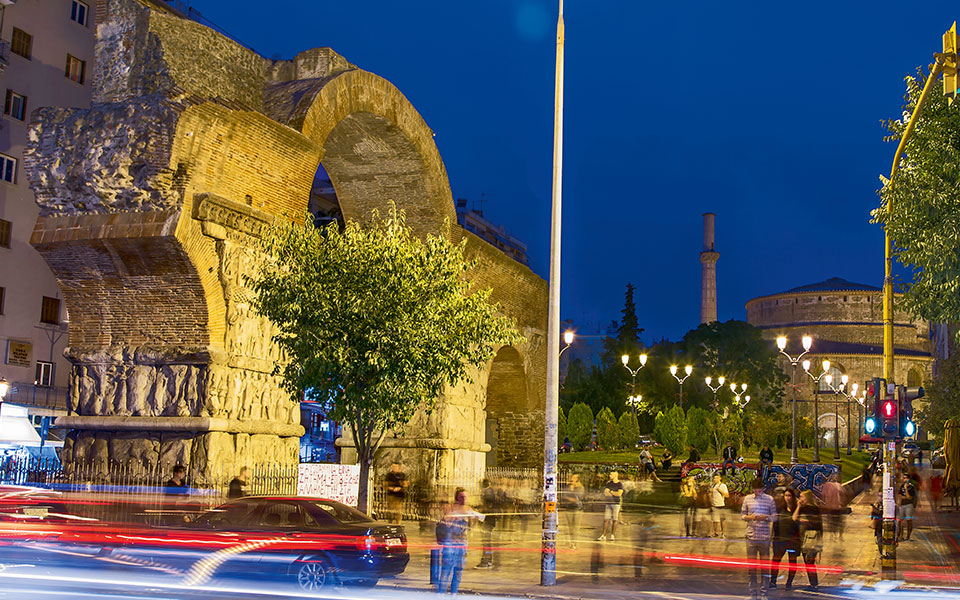
© Perikles Merakos
Today, historic monuments, museums and inscribed memorials shed intriguing and sometimes disturbing light on Thessaloniki’s rich, multi-ethnic past. Roman life and imperial rule are brought to mind by the archaeological traces of the main marketplace (agora) and Galerius’ once-lavish palace, while Byzantine and Ottoman times are recalled in the city’s towers and defensive walls, domed mosques and public baths, as well as in the splendidly decorated churches and narrow, twisting lanes of Ano Poli (the Upper Town).
At the Archaeological Museum of Thessaloniki (AMTH) and the Museum of Byzantine Culture, visitors will find excellent thematic displays that cover prehistoric times, ancient daily life, the rise of cities and imperial dynasties, religious worship and funerary customs. Mosaics, sculptures, gold artifacts, elegant icons and decorative elements from Early Christian churches are just some of the highlights. Reminders of Thessaloniki’s once-thriving Jewish community are preserved among Roman-era sarcophagi outside AMTH, at the Jewish Museum and at key spots around town.
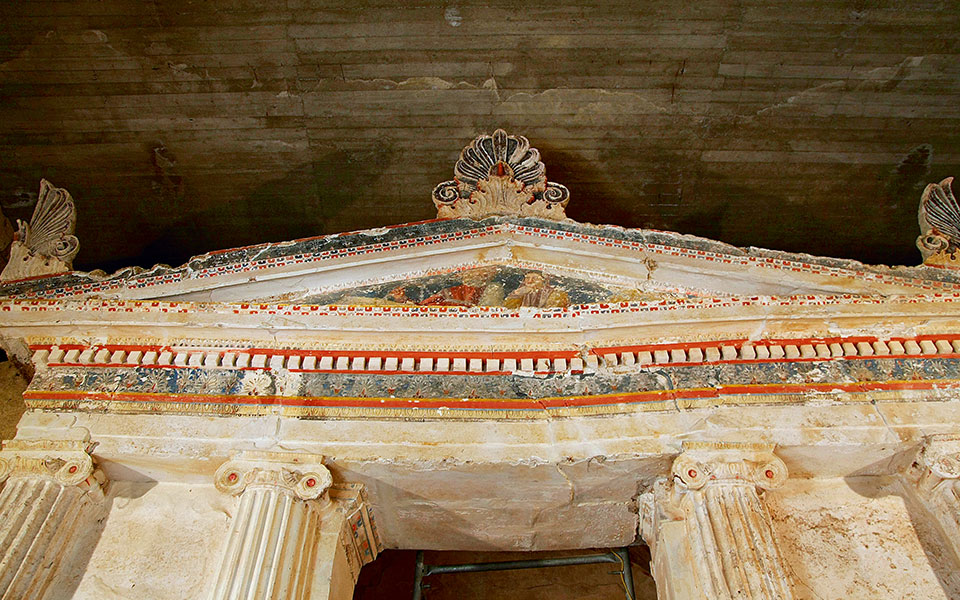
© Visual Hellas
LEFKADIA, MIEZA
In the area of Lefkadia and Kopanos are four fine examples of aristocratic, “Macedonian-type” chamber tombs. These multi-roomed, subterranean family crypts, accessed by ramps, were constructed of limestone blocks with barrel-vaulted roofs. Their stucco facades and colorful frescos are distinguished by an eclectic style assembled from various Classical elements, designed as a tribute to Greek domestic and temple architecture, mythology and history.
The two-storied Tomb of the Judgment (325-300 BC) had four Doric half-columns flanking its entrance, with metopes depicting the Centauromachy. Painted between the columns was the deceased Macedonian noble’s descent to Hades, escorted by Hermes and overseen by two judges. Above, there was an Ionic frieze showing Greeks/Macedonians fighting barbarians/Persians, six Ionic half-columns and a triangular pediment.
The Tomb of the Palmettes (300-250 BC) featured an Ionic façade with a polychrome entablature and pediment, and large palmette antefixes adorning the roof. The antechamber’s ceiling was frescoed with more palmettes, water lilies and twisting tendrils, perhaps an allusion to the underworld landscape of Lake Acheron.
The contemporary Kinch Tomb contained a fresco of a Macedonian knight spearing a Persian soldier, while the interior of the Tomb of Lyson and Kallikles (200-150 BC) was painted with fourteen seemingly 3-D Ionic piers, draped garlands, armor panoplies and Macedonian shields, all in green, red, blue, brown and black.
At nearby Mieza, the so-called School of Aristotle (Nymphaion) occupied a cave complex beside a shady river, augmented with a pi-shaped Ionic stoa. Philip sent Alexander here to be tutored by Aristotle, beginning about 343 BC.
INFO
90 km from Thessaloniki Lefkadia, Naoussa
Tel. (+30) 2332.041.121
Open daily 10:00-18:00, Fri by appointment only (in winter, all visits by appointment only)
Admission is free
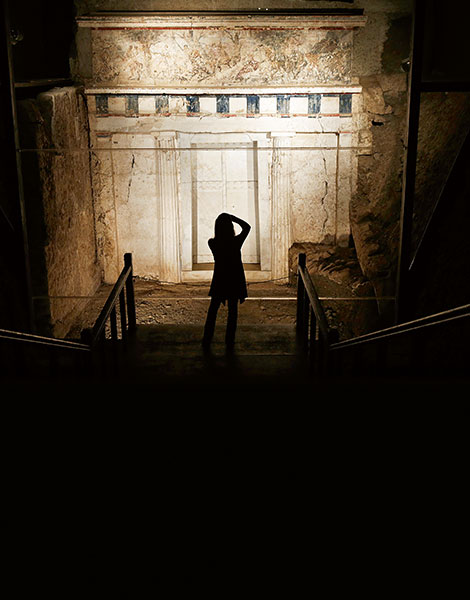
© AP Photo/Petros Giannakouris
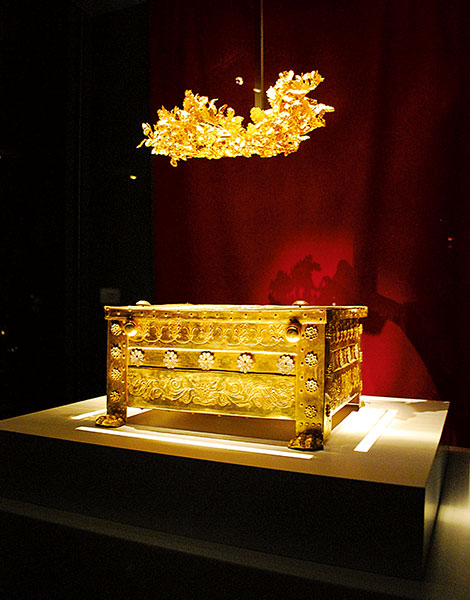
AIGAI (VERGINA)
A unique cultural monument not to be missed is the archaeological site and museum at Aigai (Vergina), the original Macedonian capital. Aigai’s small theater was already notorious in antiquity as the scene of King Philip II’s shocking assassination in 336 BC by his resentful ex-lover Pausanias. Although this was an ignoble end for a great king and highly successful military commander, Philip’s “fast” lifestyle, overweening arrogance and abrupt fall at Aigai opened the way for his soon-to-be “Great” scion, Alexander III.
Aigai also served as a royal burial ground, where the largest tumulus, excavated by Manolis Andronikos in 1977, was found to contain the lavishly interred remains of (many believe) Philip II. Specialists agree this mound, now restored above one of Greece’s most impressive museums, was the final resting place of Philip and of Alexander the Great’s son, Alexander IV; however, as with all archaeological narratives when analyses are completed and further data become available, Philip’s story today is taking on fresh complexity.
As scholars continue debating, they leave us with intriguing questions. Was Philip buried in Tomb II or next door in Tomb I? If Philip is not in Tomb II, is it possible that its occupant was his son, Philip III Arrhidaeus? Was the ambitious Cassander behind the elaborate burials of Tomb II, perhaps even including Alexander’s personal armor to signify a definitive end to the Argaead dynasty and the launch of his own Antipatrids? However the mystery may ultimately be resolved, Vergina’s extraordinary museum captures all the dramatic essence of what it meant to be an ancient Macedonian.
INFO
70 km from Thessaloniki, 8km southeast of Veria Aigai, Imathia
Tel. (+30) 2331.092.347
Open Mon 12:00-20:00, Tue-Sun 8:00-20:00 (winter hours Tue-Sun 9:00-17:00).
Admission for the archaeological site & museum €12 (€6 in winter) Combined admission: €14 (valid for three days and includes entry to: Museum of the Royal Tombs of Aigai, the Archaeological Museum of Veria and the Byzantine Museum of Veria).
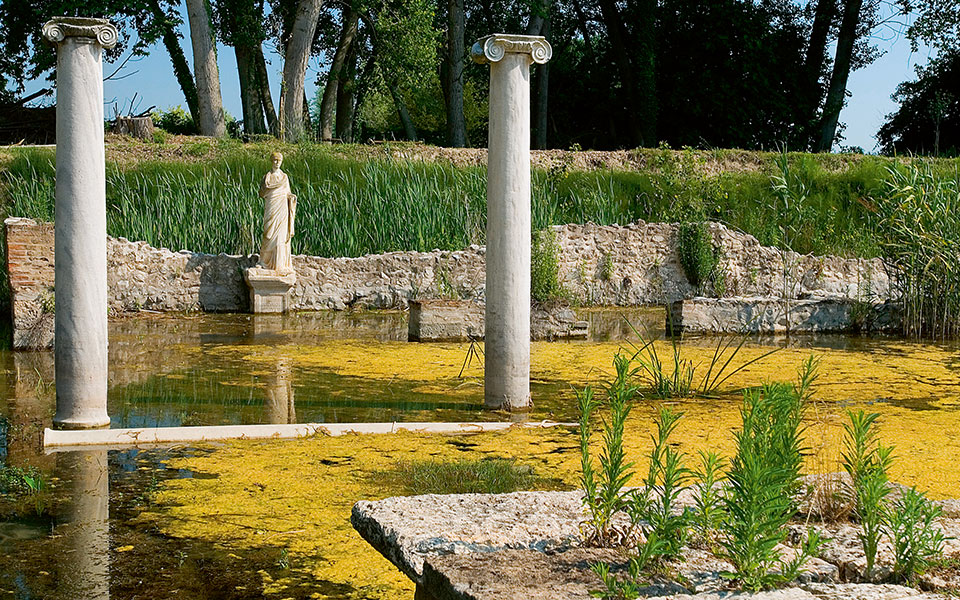
© Shutterstock
DION
In Macedonia’s well-watered southern borderlands, at the foot of Mt Olympus, lies Dion, a place of great religious reverence and cultural importance, said to be the birthplace of Zeus’ son Macedon. Shrines were established here, dedicated to Zeus and the Muses, as well as to Artemis, Aphrodite, Demeter, Dionysus and Isis.
Philip II and Alexander the Great often frequented Dion which, in military terms, was essentially a frontier fortress surrounded by thick walls and heavily garrisoned by Macedonian troops. Philip selected Dion as the site for his own Macedonian athletic games, like those at Olympia, dedicated to Zeus. Dramatic contests, also held during this nine-day festival, likely included performances of Euripides’ Archelaos and the Bacchae, which the playwright wrote while in residence at Pella. Alexander, too, favored Dion; it was here that he mustered his troops and staged extravagant celebrations before departing for Asia in 334 BC. Later, he erected proud memorials at Dion for his fallen comrades.
With the Romans’ seizure of Dion in 169 BC, and their decisive defeat of the Macedonians at Pydna the following year, the town became a colony under the auspices of Octavius (later Augustus). It was highly regarded for its stone-paved streets, ornate public baths, theater, music hall, basilicas and wealthy private residences, exemplified by the so-called Villa of Dionysus. Today, Dion represents a pleasant archaeological park beside the Vaphyras River, with tree-lined paths interconnecting its occasionally flooded sanctuaries. Its museum is filled with exquisite statuary and other traces of the fine life once lived within its walls.
INFO
89 km from Thessaloniki
Dion Archaeological Park, Pieria Tel. (+30) 2351.053.484 Open daily 8:00-18:00 (winter hours 8:00-15:00)
Archaeological Museum of Dion Tel. (+30) 2351.053.206 Open daily 8:00-20:00 (winter hours Tue-Sun 8:30-15:00) Admission:€8 (€4 in winter)
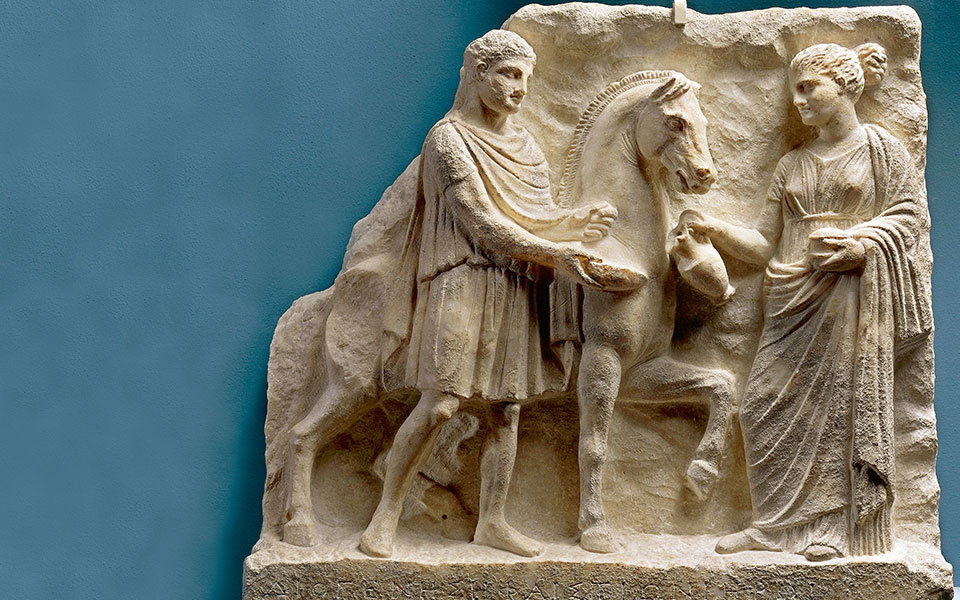
© Deagostini/Getty Images/Ideal Image
PELLA
At Pella, looks can be deceiving! What now appears as a remote ruin amid an agriculturally rich plain was once a bustling major seaport and new royal seat for Macedonia, founded in the late 5th c. BC. Here was where Philip II masterminded the expansion of his kingdom, where Alexander the Great was born and raised, and where, after Alexander’s death, Cassander ruthlessly plotted to eliminate the remaining Argaeads, confirming his grip on Macedonian power. Pella was a prosperous city – at its height the largest in Macedonia. The remains of its palace, large agora, grid-planned avenues and affluent houses with colonnaded courtyards can still be seen today.
A visit to Pella means also walking in the footsteps of Alexander’s closest companion Hephaestion, his ill-fated officer Cleitus the Black and his teacher Aristotle. Other visitors were renowned writers, artists and thinkers, including the playwright Euripides; the historian Hieronymus of Cardia; the master painter Zeuxis; the poets Agathon, Timotheus and Aratus; and the Stoic philosopher Persaeus of Citium, who came in place of Zeno. Pella attracted top mosaicists, who oversaw a far-reaching development from geometrically designed pebble floors to finely tessellated scenes like painted canvases; among the themes are stag or lion hunts and Dionysus riding on a cheetah.
In the 1st c. BC, Pella underwent major changes. It suffered a damaging earthquake, became a Roman colony, and eventually slipped into decline, perhaps largely due to the silting-in of its port. Today, Pella is one of Macedonia’s most active, promising archaeological sites, with a new, state-of-the-art museum that thematically presents the life of this fascinating city.
INFO
46 km from Thessaloniki, 35th kilometer of the Old National Road, Thessaloniki – Edessa, Pella
Tel. (+30) 2382.031.160
Archaeological park open daily 08:00-18:00 (winter hours 9:00-15:00). Museum open daily 08:00-20:00 (winter hours 9:00-15:00)
Admission:€8 (€4 in winter)

© Greek Culture Ministry
AMPHIPOLIS
At the top of the Aegean stands Amphipolis, another important, heavily fortified military base used by Alexander the Great for mustering his Asia-bound troops. Strategically located at the nexus of nine traditional land routes, the original settlement of “Ennea Hodoi” came to be hotly contested among the local Thracians, Athenians, Spartans and Macedonians during the 5th c. BC. The Athenians, trying to establish a colony here in 465 BC, lost as many as 10,000 settlers, killed by neighboring tribesmen. They tried again, more successfully, in 437 BC – only to be attacked thirteen years later by the Spartans, whose leader Brasidas fell in battle and was later given a hero’s burial by the inhabitants.
The Macedonians, under Philip II, seized the port town in 358 BC, developing it as a stepping stone to the mineral riches of Thrace and the Asian frontier. Following Alexander’s death (323 BC), Cassander ordered Queen Roxana and her young son Alexander IV held prisoner in the fortress, where they were eventually poisoned. Amphipolis later served as the capital of Roman Macedonia, while in the 5th and 6th c. AD it became a flourishing Early Christian community, with five churches and a bishop’s palace.
Recent excavations on Kasta Hill, by the 28th Ephorate of Prehistoric and Classical Antiquities, have revealed a Macedonian-style tomb (late 4th c. BC) encircled by an enormous wall (158m diam.) of white Thasian marble. Who – among the five burials (newborn – 60+ years) discovered in the tomb – was the main occupant? Mystery prevails for the moment…
INFO
98 km from Thessaloniki, Amphipolis, Serres
Tel. (+30) 2322.032.474
Open daily 8:00-18:00 (winter hours Tue-Sun 8:00-15:00)
Admission for archaeological site & museum €6 (€3 in winter).
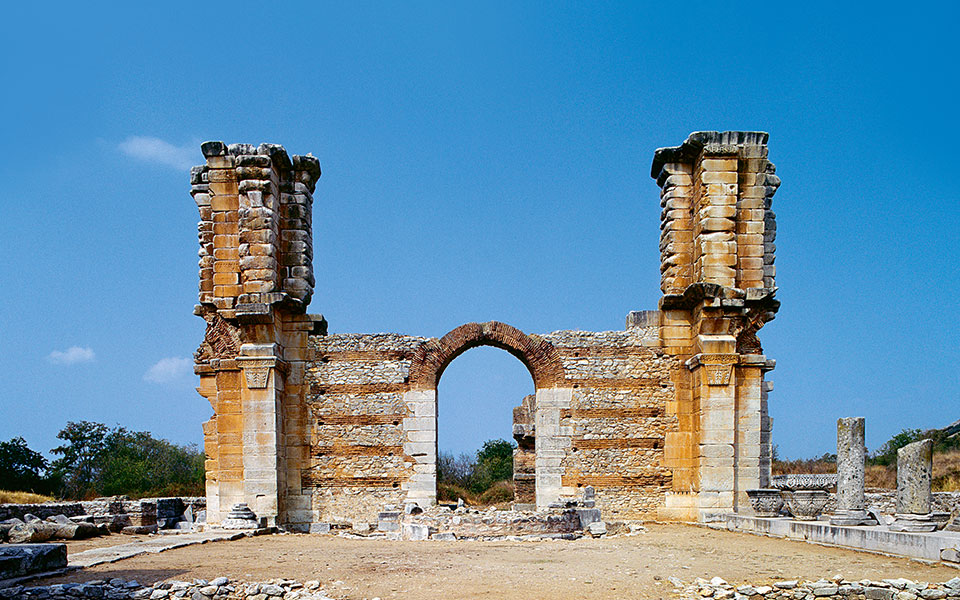
© Deagostini/Archivio J. Lange/Getty Images/Ideal Image
PHILIPPI
Philippi, like Amphipolis, lay beside the Via Egnatia, the major east-west Roman highway, along which flowed a steady human tide of troops, officials, merchants and common travelers. Macedonia and Thrace were a key link in the long journey between Rome and Byzantium/Constantinople. Philippi, established ca. 360 BC as “Krenides” by colonists from Thasos, was taken over by Philip II only four years later and renamed. Philip wished to control not only the highway but the newly discovered gold mines at nearby Asyla as well, which he exploited to great economic advantage.
Under the Romans, Philippi became the scene, in 42 BC, of an historic showdown between Julius Caesar’s assassins and his avenging heirs, Marc Antony and Octavian (Augustus). After winning the battle, the latter set about transforming Philippi into an affluent veterans’ colony that capitalized on its strategic position and rich local resources. This pagan city, in need of spiritual guidance, drew the interest of the apostle Paul, who first arrived at Philippi in AD 49/50, then returned for a second visit in AD 56/57. In the wake of his persuasive teachings, the Early Christian community of Philippi flourished, and much material wealth was directed toward the development of its religious infrastructure.
Two millennia later, the site of Philippi offers an extraordinary expanse of elaborate ruins, including a fortified acropolis, large agora, a now-partly-reconstructed theater and numerous sanctuaries, churches, baths, shops, public buildings and common dwellings, as well as luxurious mosaic-floored bishops’ residences.
Please note: Winter hours apply from November 1st to March 31st.
INFO
160 km from Thessaloniki Philippi, Kavala
Tel. (+30) 2510.516.470
Open daily 08:00-17:00 (winter hours 08:00-17:00)
Admission for the archaeological site & museum €6 (€3 in winter).












